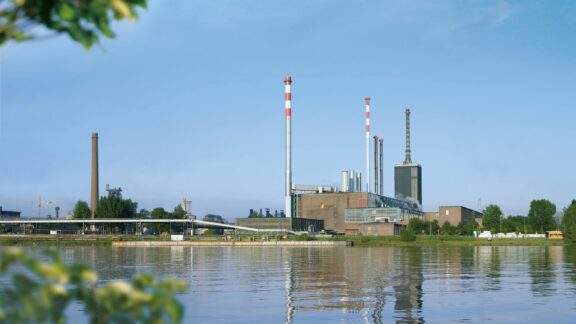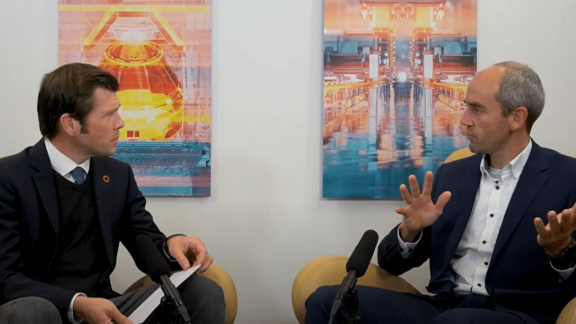In this session of “Pioneers Talk”, we sit down with Data Analyst Manuel Sattler to discuss how the utilization of data can improve the operation of electric arc furnaces.
Pioneers Talk is the new video format of Primetals Technologies, focusing on informative and empowering interviews with experts in metals production and beyond. Topics extend to new advances in digitalization and automation, breakthroughs in green-production solutions, and success strategies for steel producers on all continents.

Interview with
Manuel Sattler
Welcome to today’s Pioneers Talk: Meet EAF Performance Targets Using Data Analytics. My name is Christoph Stangl, and I will be your moderator today and my today’s guest is Manuel Sattler, data analyst for Primetals Technologies.
Sattler: Thanks for inviting me today.
Nice to have you here. In the next 30 minutes, Manuel and I will discuss that often the little things make a big difference when talking about the performance of your EAF plant and why this is the case. We will have a look at the solution that determines improvements for EAF performance based on operation practice using data analytics methods and we will have a look or share insights how you can transfer generated information automatically to your automation solution system and why this is important. So, this is a Pioneers Talk interview so let’s start pioneering! Well, before we really start with the discussion, Manuel, I would like to show a very quick result of an online survey I did. Maybe we can show this result of the online survey to our participants. You can see I asked the question if our participants already use data analytics methods in the steel plant and as we can see more than sixty-two percent said yes, we use data analytics methods. If you’re willing to share for what kind of applications, we would be glad about it. Another 12 percent said not yet, but they plan to use data analytics methods in the future. 13 percent say they are not quite sure if they use it, another 13 percent are not interested in data solutions right now. Hopefully we can convince you with this interview that this makes a lot of sense for your EAF performance improvement. Thanks for sharing. Now, Manuel you have developed a solution that improves the performance of an EAF based on operation practice using data analytics methods and you presented this solution in a conference named Pioneers Connect 21 in spring of this year and it received a lot of interest. To start, you told me just prior to this interview that usually with an EAF, operators enter all the rules and recipes for the operation and then it’s operated very statically and stable and this is sub-optimal. Can you elaborate why this is the case?
Sattler: When we go to the plant, we make the startup and everything, we have to meet the performance values. For these performance values we create the optimal steel making practice which is based on the materials we have at that moment. We have scrap, dolo, lime and all these things and they can change over time. So, if these things change because you have more scrap qualities, your supplier for your electrodes changes, you have different qualities of lime or dolo, you also need to tweak a little bit the steel making practice to stay at the optimum and from our experience this might not always happen. The responsible operator for it is usually loaded with other work. For example, they are dealing with quality of scrap, quality of the steel, of the final steel and such things so it’s just a small part which can make a big difference on the outcome.
Very interesting. I think you told me once that it’s really a matter of minutes or seconds like scheduling the sequence of the baskets how they were actually preheated or input into the EAF. Why is this so crucial? I was surprised that these kind of minor time frames really make a difference.
Sattler: We got some sample data and it was really interesting. We found that, for example, if you have the first basket just a few minutes longer and also the second basket a few minutes longer, it was actually first basket was one and a half minutes long and the second basket was half a minute longer, in total two minutes and then at the third basket we could save four minutes. For us it was kind of surprising that good timing really makes such a difference in the tap-to-tap time or the power-on time, depending on what you’re focusing on.
In your experience, are the operators of an EAF usually aware of this? Or do you see know-how fade out now over time when the more senior operators retire?
Sattler: I think the operators are aware of that. Everybody is aware that the good timing of the baskets is really crucial for the success of a heat. But every heat is kind of different, you have different scrap recipes and all that and so it’s also for the operator pretty difficult to find the perfect spot when to charge and when not to charge. Timing is crucial even for gas, oxygen, and the slag builders, so yes, timing is crucial.
Is this something you experience only specifically with EAF operations or also with other aggregates?
Sattler: Usually for other aggregates, most of the time you know what is coming. If you have for example an EAF route followed by a ladle furnace, you have a sample of the EAF and you know what’s going into the EAF. There’s no surprise there. On the other hand, if you put scrap into an EAF, there might be some surprises, so it’s very difficult to get a real model there which is always working perfectly and that’s one of the things we thought we want to solve.
Thanks, Manuel, for your first insights. We’ve just discussed this problem or this challenge how to improve the performance of an EAF and for this purpose you have developed a solution called EAF Heat Cloning. You have also presented this solution already at a conference in April this year. Maybe you can just describe a bit more what this solution looks like and how it works?
Sattler: The diagram you can see shows that at the beginning we are clustering this scrap, it’s not really rocket science, we cluster the scrap according to quality and weight. We get this cluster where we know that we have certain scrap qualities. It’s just clustering of what we know is going in to the EAF and we then find for each cluster the reference heat and we think reference heat is one of the most important steps because it defines the outcome of our search. For example, if you want to increase productivity of your EAF this reference heat should also reflect that productivity approach, it should be a highly productive heat. On the other hand, if you want to improve for example costs or something like that the reference heat should be a very cost-efficient heat and the other steps also three and four are usually there to check if this heat is repeatable. At step three, we look at the aggregated data, one would say level two data or reporting data something like that, so we find these potential heats where these gold nuggets or these similar heats are and with that potential heat or with that potential pool of heats, we really go into the time series of data. We check when did the operator push the carbon button or when was the gas or oxygen activated and we then compare it to find similarities, where we find this last cluster and then we can see that this reference heat was produced 10 or 15 times and it’s realistic that we can reproduce that. From that we extract the best practice and at the end it’s more or less just a table which you can hand to the operator and try it and check the outcome.
This looks like very comprehensive and very specific, thanks for sharing the chart. Now as far as I understand it’s all about getting the data to then apply the solution. This is quite a sensitive topic so is it easy or difficult, what is your experience?
Sattler: You always have to prove what you’re doing with the data, if you can prove that the steel producer gains an advantage it’s usually pretty easy. But when you say, I want data to just have data and nobody knows what is done with the data it really gets difficult and so we need a transparent approach that we really can check what is done with the data step for step so everybody can follow it.
There are different kind of concepts how to collect data as a steel producer and in your experience is it more often the case that data is available in a data lake without any structure or are we getting them from a data warehouse or other types of data interfaces?
Sattler: Usually we don’t care how we get the data, if we connect to a data lake or to an SQL database where everything is really nicely structured. We have a very flexible approach. We need to get the data in some way, then we transform the data ourselves or the customer can already do it if you can identify what they are interested in and if they think there are some data signals which are very important, they can spare it out and that’s it. The only thing we really want is that the data quality should be okay and the second thing is it should be really comprehensive, most of the data should be in there so that the results can be used.
Would you then for example support steel producers to make sure that you have the proper data points plus to validate them that they have the proper setup?
Sattler: Sure, you have to talk. There’s no way around that.
The solution presented has these five steps. Is this normally one solution or is it a combination of solutions that execute these steps?
Sattler: There are some manual steps, for example defining the reference heat, but the search steps are more or less automated. We can tweak it a little bit, for example if electric consumption is more important, we want to focus a little bit on that and put some weight on it. The last search steps then are automated.
One point I would like to come back to, because we pointed it out in your description, is that this EAF Heat Cloning solution is really based on operations practice. It’s not like out-of-the-box or standard. Maybe you can just describe again how this works and why this is important in your opinion?
Sattler: We know how to build plants and our customers are good at operating plants, so we don’t want to have some kind of model in that direction which is predicting something with an accuracy of 95 or 99 percent, which it’s pretty good. But that’s not what we want because you have a five percent failure rate. We think that our customers are really good at operating plants and so we just look into the data and check what happened in the past. What we extract from there is not something which we fantasize about but it’s just a little help for our customers to see what they have done in the past and what they have done well in the past and how they can keep this up in the future.
Proceed, let me quickly try to summarize, Manual, but what I understood so far is that operating an EAF is whenever it’s stable or a static process…
Sattler: That’s steel making practice, you’re still at level two and steel making practice is in the background and it tells the operator when to push the buttons, it just tells to push the buttons and the operator can decide otherwise. The thing is that steel making practice is often not adapted.
But this usually means operators just stick to the extended operation mode.
Sattler: Yes, because it worked in the past, so why shouldn’t it work now.
So, this means that it is well operated, but that they miss some potential to improve the performance, to improve productivity, or to improve profit or quality?
Sattler: In my opinion, EAF must have some kind of targets. For example, if steel prices are high you need to produce as much as possible to get a lot of profit out of it. You want to focus on productivity and that’s what we do then with the reference heat. On the other side, if the steel prices are low, you want to produce as cost-efficient as possible to get at least some profit out of it and you don’t care about how much you produce because steel prices are low and you just want to be cost-efficient to still have some profit. That’s what we try to achieve with our reference heat and what we can achieve with our tool. We can easily switch that, so we can extract these SMPs, steel making practices, within one or one and a half days and then we can say hey here’s your new plan and you can switch the target which adds some flexibility.
If you’re now a very advanced senior operator of an EAF and have years of experience, why isn’t such a person able to look at the performance of the data and analyze it? Why do they need this kind of tool?
Sattler: Seasoned operators will retire at one point and new operators will need to learn this over the time. Operators in my experience just get better over time and with experience and so if this one operator you talked about is really good, we will find his heat in the data and we will make it a best practice. We will extract his knowledge on how to process with certain steel grades and deliver it to all the operators, not just one.
Does this tool then also serve as a solution to collect and grow corporate know-how?
Sattler: That’s a good question, probably yes. If there are good heats of one operator who was good at cost-efficiency, who retired. So, if you change the target of your EAF from the last three years where you focused on productivity and you find this data from five years ago, then you can renew it and put it back into operation again.
My impression is that this is a really big topic currently. Not only steel producers but all industries have this problem that experienced people retire and it’s difficult to find highly skilled people as replacement, so this is a very interesting aspect. We have received some comments and we will now go through them. One is asking can one apply this Heat Cloning technology to Fuchs Finger Shaft-type furnaces?
Sattler: Fuchs Finger Shaft was the predecessor of the EAF Quantum.
Is this applicable there?
Sattler: I know that the finger shaft is still used but I’m not sure how much hot heel it has. The thing with hot heel is that it influences the heat, the outcome of the heat a lot and if there is a constant hot heel, we can apply that.
Another question from the chat, it’s a bit tricky but let’s try. Do you have any data you would like to share how much the efficiency can be increased by a heat cloning app? Five percent, two percent, twenty?
Sattler: Unfortunately, we haven’t managed to put it into practice yet. We got some real data, we made our studies on that and one of the reasons we are doing this today is to find EAF operators who would be interested in working together with us to see how much it really takes or how much you can really get out of it?
It’s an important point. If you’re really interested now to utilize this technology and improve the performance of your furnace, please contact Manuel Sattler. There’s another question stating that currently electrodes are extremely expensive. Can the methodology you just presented adjust a process to minimize the electrode consumption?
Sattler: It depends on the data. Usually electrodes are weighted, depending on the operational practice, once a week or once a day maybe. It’s pretty hard to really say which heat had which electrodes consumption. I wouldn’t say it’s impossible but with our method it’s probably not that feasible because we’re checking the heats and if you just have an average electric consumption, I don’t think it will work.
Thanks for sharing this kind of limitation too. There’s another question asking if there is an automation algorithm behind the solution or do all the steps of the heat cloning concept need to be done manually?
Sattler: It’s really hard to have an automation concept for the reference heat because it depends on the target of the EAF. You can also have the clustering done automatically and we have automated the search algorithms as well as the data extraction. We finished that three weeks ago and it worked really well. For the reference heat though, it’s one of the things where you still need a human brain and an expert who evaluates the path we want to go with.
Isn’t this very often the case to say if we have big data, what is obviously the case in this application, you need data analytics methods to just determine patterns and gain insights?
Sattler: If you look at level one data for three years, for every two seconds you have one row. So, you have millions of rows that you have to automate because otherwise it’s not possible. We also have these two steps, because to compare the time series with tens of thousands of sheets of time series data you need a pc cluster and big pc machine and so we have this two-search approach to get the potentials and then the time series.
There’s another question from the comments. Which type of data analysis is used for this technology? Is it a statistical neural network or something else?
Sattler: Neural networks create a model with which they predict something and that’s not the path we wanted to go. If you have a model for predictions, you always have this error margin and in situations, with which they are not familiar, they’re predicting sometimes absurd things. That is why we have statistical models which are based on the past and we extracted data from those and then we use machine learning algorithms.
One last question in this live stream is, what are the prerequisites for this solution? The querist states that he might not have the data in one location, for example it might be in an excel file or other forms of data in the data history. So, is it possible then to connect those to your tool?
Sattler: As I said whether it’s a data lake or an excel file, we can deal with it. We have to put it in one place at some point. That’s not a problem if we have different data sources because we just put them in one place and then we continue to work with that.
Do also provide this kind of database?
Sattler: We will put it into a data warehouse, our own data warehouse, and then we put our solution on top of the data warehouse.
We’re now really close to the end of this live stream. Thanks a lot for joining this first livestreamed Pioneers Talk interview, I’m very glad that Manuel Sattler, data analyst at Primetals Technologies, was here and I’m very glad about the insights you gave us about the solution for EAF Heat Cloning. If you are now interested in applying this solution to your furnace or would like to have more details please either leave a comment to this live stream, or if you are seeing our recording of the live stream please also leave a comment. You can also contact Manuel Sattler directly via LinkedIn and if you like our video format please feel free to leave a comment. Our next upcoming Pioneers Talk will be on the second of December this year titled “From Automation to Digitalization and if you want to be sure not to miss any upcoming Pioneers Talk follow our hashtag #pioneerstalk or follow me on LinkedIn. Thanks again, Manuel, for being here. It was a pleasure. Thanks for visiting and goodbye.
Sattler: Thanks, goodbye.
Manuel Sattler
Experienced Product Developer with a demonstrated history of working in the mechanical or industrial engineering industry. Skilled in Analytical Skills, Business Development, Big Data Analytics, and Data Modeling. Strong product management professional with a Bachelor’s degree focused in Logistics, Materials, and Supply Chain Management from Montanuniversität Leoben.
Dr. Christoph Stangl
Christoph Stangl has more than 25 years international experience in marketing, sales, consulting, manufacturing and (information) technology. At Primetals Technologies he acts as moderator, conceptioner and creator of remarkable content. Christoph focuses on the needs, pains, gains and solutions of steel producers to improve the automation, optimization and digitalization of their steel plants.


